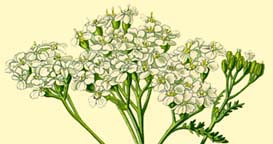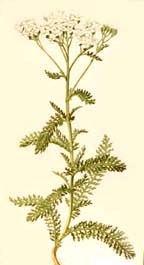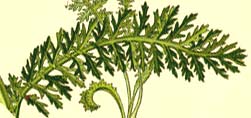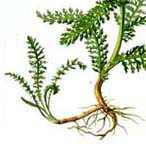 Achillea millefolium
Achillea millefolium
Wild Yarrow
A native of
Eurasia, yarrow has been cultivated in Europe
since before 1440 and like many of us, became
naturalized in North America. Fossils of this
plant have been found at Neanderthal burial sites,
so it has been a friend to human(oid)s for a long
time. The handsome leaves are nicely aromatic,
especially in the early morning dew or just after
a rain; they sometimes remain green even
underneath snow. Some people (and ants) do
not like the smell, which is probably where yarrow
got its "devilish" reputation. It was commonly
used to flavor a type of beer called gruit before the introduction of
hops (the other two main ingredients being bog
myrtle and marsh rosemary), and it still flavors vermouth and bitters.
Very young and small leaves were eaten sparingly
in the 17th century in salads. In Greek mythology,
yarrow grew from the rust that Achilles (thus,
Achillea) scraped from his spear to help heal a
man he himself had wounded (there's an interesting
connection between iron/rust/blood/war/
Mars
here, kind of a
neat obverse of the
Venus/love
aspect of this herb). In the language of flowers,
it can mean war or healing. Bees, ladybugs, and
butterflies enjoy the flowers, which when dried,
make a great potpourri ingredient.
Top
In
Magic
 Although there is
something very Mercury about
this magick herb (perhaps it's the scent), most
consider it ruled by Venus on account of its
helpfulness to wounds and skin problems. Because
it is aromatic, yarrow is also associated with the
Element of Air, and it contains the planetary
metal for Jupiter (tin). Magickally, it has much
usefulness for divination; the I Ching was
originally thrown not with coins but with dried
yarrow stalks. It is a good ingredient for
dream pillows and for divinatory incense and tea
(see
Third
Eye Ritual), and burning it is said to produce
visions of snakes, so it makes a great addition to
the witch's garden. Yarrow also has the ability to
potentiate other herbs when added to incense or
when incorporated into love magick. This plant has
often been a device for divining the identity of
one's future lover or determining whether one is
truly loved. It is incorporated into love sachets,
because it is believed capable of keeping a couple
together for 7 years. In the past, yarrow was used
as a protectant. It was strewn across the
threshold to keep out evil and worn to protect
against hexes. It was tied to an infant's cradle
to protect it from those who might try to steal
its soul. The Saxons wore amulets made of this
plant to protect against blindness, robbers, and
dogs, among other things. An interesting Gaelic
woman's incantation spoken when picking yarrow
goes: "I will pick the smooth yarrow that my
figure may be sweeter, that my lips may be warmer,
that my voice may be gladder. May my voice be like
a sunbeam; may my lips be like the juice of the
strawberry. May I be an island in the sea; may I
be a star in the dark time, may I be a staff to
the weak one. I shall wound every man, and no man
shall hurt me." I have seen contradictory info
about the relationship of this herb to fairies.
Some say fairies favor yarrow, but others
say that the plant repels fairies.
Top
Although there is
something very Mercury about
this magick herb (perhaps it's the scent), most
consider it ruled by Venus on account of its
helpfulness to wounds and skin problems. Because
it is aromatic, yarrow is also associated with the
Element of Air, and it contains the planetary
metal for Jupiter (tin). Magickally, it has much
usefulness for divination; the I Ching was
originally thrown not with coins but with dried
yarrow stalks. It is a good ingredient for
dream pillows and for divinatory incense and tea
(see
Third
Eye Ritual), and burning it is said to produce
visions of snakes, so it makes a great addition to
the witch's garden. Yarrow also has the ability to
potentiate other herbs when added to incense or
when incorporated into love magick. This plant has
often been a device for divining the identity of
one's future lover or determining whether one is
truly loved. It is incorporated into love sachets,
because it is believed capable of keeping a couple
together for 7 years. In the past, yarrow was used
as a protectant. It was strewn across the
threshold to keep out evil and worn to protect
against hexes. It was tied to an infant's cradle
to protect it from those who might try to steal
its soul. The Saxons wore amulets made of this
plant to protect against blindness, robbers, and
dogs, among other things. An interesting Gaelic
woman's incantation spoken when picking yarrow
goes: "I will pick the smooth yarrow that my
figure may be sweeter, that my lips may be warmer,
that my voice may be gladder. May my voice be like
a sunbeam; may my lips be like the juice of the
strawberry. May I be an island in the sea; may I
be a star in the dark time, may I be a staff to
the weak one. I shall wound every man, and no man
shall hurt me." I have seen contradictory info
about the relationship of this herb to fairies.
Some say fairies favor yarrow, but others
say that the plant repels fairies.
Top
In
Herbalism
 Culpeper considered yarrow
a Venus herb, probably because of its ability to
heal wounds, treat the skin (see
Yarrow
Skin Wash), and because in the European
tradition it helped ease various uterine problems,
such as too heavy menstrual flow. Generally, the
fresh leaves are used for poultices and the dried
ones for teas. The leaves are more
astringent, and the flowers are more aromatic. The
poultice is styptic, astringent, antiseptic, helps
heal tissue, is anti-inflammatory, and is said to
have some effect as a topical anesthetic. Smallpox
was treated with yarrow ointment. The tea has
similar effects as the poultice and in addition
tends to raise the body temperature (good for the
start of colds), works as a bitter tonic to help
digestion, helps promote healthy coughing, eases
spasms, and promotes menstruation (don't use
during pregnancy). In India, yarrow was put into
medicated steam baths for fever; the Chippewa used
it very similarly for headache. Even though this
plant was introduced by Europeans, Native
Americans have used it a great deal. Algonquin
Indians made a tea of the leaves and flowers for
headaches, the Blackfeet used a steeped tea of the
leaves to ease delivery, and the Potawatami
smudged around ill people with it. Even now, the
tea is sometimes taken as a remedy for the blues
and for restlessness, especially during menopause.
It is helpful in shedding fear and
negativity. The
flower essence
strengthens the aura and shields from disharmony
and unwanted environmental forces, such as other's
moods. Some people are allergic to this plant and
get a rash from it, and extended use cause
photosensitivity.
Top
Culpeper considered yarrow
a Venus herb, probably because of its ability to
heal wounds, treat the skin (see
Yarrow
Skin Wash), and because in the European
tradition it helped ease various uterine problems,
such as too heavy menstrual flow. Generally, the
fresh leaves are used for poultices and the dried
ones for teas. The leaves are more
astringent, and the flowers are more aromatic. The
poultice is styptic, astringent, antiseptic, helps
heal tissue, is anti-inflammatory, and is said to
have some effect as a topical anesthetic. Smallpox
was treated with yarrow ointment. The tea has
similar effects as the poultice and in addition
tends to raise the body temperature (good for the
start of colds), works as a bitter tonic to help
digestion, helps promote healthy coughing, eases
spasms, and promotes menstruation (don't use
during pregnancy). In India, yarrow was put into
medicated steam baths for fever; the Chippewa used
it very similarly for headache. Even though this
plant was introduced by Europeans, Native
Americans have used it a great deal. Algonquin
Indians made a tea of the leaves and flowers for
headaches, the Blackfeet used a steeped tea of the
leaves to ease delivery, and the Potawatami
smudged around ill people with it. Even now, the
tea is sometimes taken as a remedy for the blues
and for restlessness, especially during menopause.
It is helpful in shedding fear and
negativity. The
flower essence
strengthens the aura and shields from disharmony
and unwanted environmental forces, such as other's
moods. Some people are allergic to this plant and
get a rash from it, and extended use cause
photosensitivity.
Top
Other
Names
The many other common names for
yarrow reflect how widely this herb has been used:
allheal, angel flower, bad man's plaything,
bloodwort, cammock, carpenter's weed, devil's
nettle, devil's plaything, dog daisy, gordoloba,
green arrow, herbe militaris, hierba de las
cortadura, knight's milfoil, milfoil, nosebleed,
old man's (the devil's) mustard, old man's pepper,
plumajillo, sanguinary, soldier's woundwort,
squirrel's taile, stanchgrass, stanchweed,
thousand-leaf, thousand weed, woundwort, and
yarroway. Whatever you call it, yarrow is just an
all-around great herb.
Top
|
Achillea millefolium
Wild Yarrow
1000 seeds $3.75

Uses in
Witchcraft & Magic:
Astral Herb
Divination
Dreamwork
Love Magic
Protection Spells
Witch's Garden
Go
to dried yarrow flowers
© 2007-2024 Alchemy Works; No
reproduction without
permission.
|
|
How
to grow yarrow
 Barely press seeds into
moist soil; they need light to germinate in 5-10
days at 62-75F/18-25C. Transplant to full sun and
light soil; if the soil is rich, the stems get
floppy. Yarrow stalks get 2-4ft/60-120cm tall,
although the leaves stay close to the ground in a
rosette. Harvest flowers on the first day the they
begin to feel stiff instead of soft and hang
upside down to dry in airy place out of the sun.
Once it is established, it spread by rhizomes (see
picture) and can be invasive. Divide when it gets
crowded. Yarrow is said to intensify the flavor of
herbs grown near it. Perennial in most of North
America (zones 3-10) and in temperate
areas.
General
growing info
Top
Barely press seeds into
moist soil; they need light to germinate in 5-10
days at 62-75F/18-25C. Transplant to full sun and
light soil; if the soil is rich, the stems get
floppy. Yarrow stalks get 2-4ft/60-120cm tall,
although the leaves stay close to the ground in a
rosette. Harvest flowers on the first day the they
begin to feel stiff instead of soft and hang
upside down to dry in airy place out of the sun.
Once it is established, it spread by rhizomes (see
picture) and can be invasive. Divide when it gets
crowded. Yarrow is said to intensify the flavor of
herbs grown near it. Perennial in most of North
America (zones 3-10) and in temperate
areas.
General
growing info
Top
Third
Eye Ritual
This ritual helps improve one's
psychic powers when performed three days before
the moon is full, and preferably in either the
sign of Cancer, Pisces or Scorpio. Brew a strong
yarrow (or mugwort) tea and light thirteen purple
votive candles to help attract psychic influences.
Drink the tea and concentrate on your scrying
device (magick mirror, crystal ball, crystal
pyramid, etc.) while chanting the following
incantation three times:
I invoke thee, O Asariel,
archangel of Neptune
and ruler of clairvoyant powers.
I ask thee now to open my third eye
and show me the hidden light.
Let me see the future.
Let me see the past.
Let me perceive the divine kingdoms of the
unknown.
Let me understand the wisdom of the universe.
So mote it be!
Relax, breathe slowly, and
concentrate on opening your Third Eye, a chakra of
psychic power located in the middle of theforehead
above the space between the eyebrows.
Top
YARROW
SKIN WASH
Because yarrow is astringent
(drying), it makes a good skin wash for oily skin.
Pour 2 parts of boiling water over 1 part of
crumbled, dried yarrow flowers. Cool, strain, and
pat on skin. This wash is soothing to chapped skin
and minor irritations.
Top
|
|